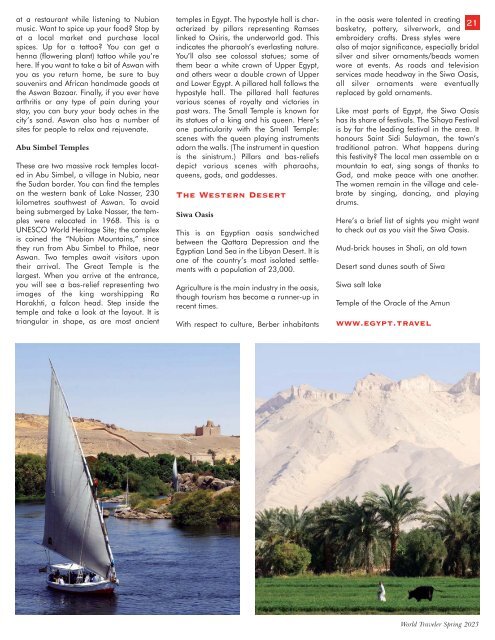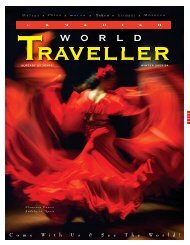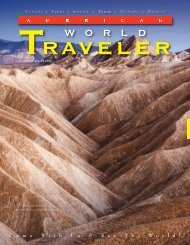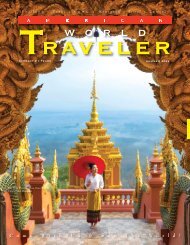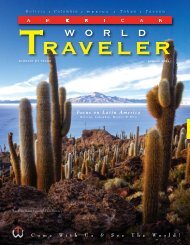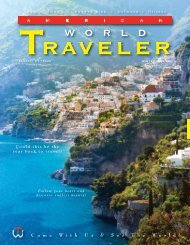Canadian World Traveller Spring 2023 Issue
Now in our 21st year of publishing, Canadian World Traveller explores the culture and history of worldwide destinations, sharing the adventure of discovery with our readers and motivating them to make their travel dreams a reality. Published quarterly, CWT helps sophisticated, independent Canadian travellers choose their next destination by offering a lively blend of intelligent, informative articles and tantalizing photographic images from our World’s best destinations, cruises, accommodations and activities to suit every traveller's taste.
Now in our 21st year of publishing, Canadian World Traveller explores the culture and history of worldwide destinations, sharing the adventure of discovery with our readers and motivating them to make their travel dreams a reality. Published quarterly, CWT helps sophisticated, independent Canadian travellers choose their next destination by offering a lively blend of intelligent, informative articles and tantalizing photographic images from our World’s best destinations, cruises, accommodations and activities to suit every traveller's taste.
You also want an ePaper? Increase the reach of your titles
YUMPU automatically turns print PDFs into web optimized ePapers that Google loves.
at a restaurant while listening to Nubian<br />
music. Want to spice up your food? Stop by<br />
at a local market and purchase local<br />
spices. Up for a tattoo? You can get a<br />
henna (flowering plant) tattoo while you’re<br />
here. If you want to take a bit of Aswan with<br />
you as you return home, be sure to buy<br />
souvenirs and African handmade goods at<br />
the Aswan Bazaar. Finally, if you ever have<br />
arthritis or any type of pain during your<br />
stay, you can bury your body aches in the<br />
city’s sand. Aswan also has a number of<br />
sites for people to relax and rejuvenate.<br />
Abu Simbel Temples<br />
These are two massive rock temples located<br />
in Abu Simbel, a village in Nubia, near<br />
the Sudan border. You can find the temples<br />
on the western bank of Lake Nasser, 230<br />
kilometres southwest of Aswan. To avoid<br />
being submerged by Lake Nasser, the temples<br />
were relocated in 1968. This is a<br />
UNESCO <strong>World</strong> Heritage Site; the complex<br />
is coined the “Nubian Mountains,” since<br />
they run from Abu Simbel to Philae, near<br />
Aswan. Two temples await visitors upon<br />
their arrival. The Great Temple is the<br />
largest. When you arrive at the entrance,<br />
you will see a bas-relief representing two<br />
images of the king worshipping Ra<br />
Harakhti, a falcon head. Step inside the<br />
temple and take a look at the layout. It is<br />
triangular in shape, as are most ancient<br />
temples in Egypt. The hypostyle hall is characterized<br />
by pillars representing Ramses<br />
linked to Osiris, the underworld god. This<br />
indicates the pharaoh’s everlasting nature.<br />
You’ll also see colossal statues; some of<br />
them bear a white crown of Upper Egypt,<br />
and others wear a double crown of Upper<br />
and Lower Egypt. A pillared hall follows the<br />
hypostyle hall. The pillared hall features<br />
various scenes of royalty and victories in<br />
past wars. The Small Temple is known for<br />
its statues of a king and his queen. Here’s<br />
one particularity with the Small Temple:<br />
scenes with the queen playing instruments<br />
adorn the walls. (The instrument in question<br />
is the sinistrum.) Pillars and bas-reliefs<br />
depict various scenes with pharaohs,<br />
queens, gods, and goddesses.<br />
The Western Desert<br />
Siwa Oasis<br />
This is an Egyptian oasis sandwiched<br />
between the Qattara Depression and the<br />
Egyptian Land Sea in the Libyan Desert. It is<br />
one of the country’s most isolated settlements<br />
with a population of 23,000.<br />
Agriculture is the main industry in the oasis,<br />
though tourism has become a runner-up in<br />
recent times.<br />
With respect to culture, Berber inhabitants<br />
in the oasis were talented in creating<br />
basketry, pottery, silverwork, and<br />
embroidery crafts. Dress styles were<br />
also of major significance, especially bridal<br />
silver and silver ornaments/beads women<br />
wore at events. As roads and television<br />
services made headway in the Siwa Oasis,<br />
all silver ornaments were eventually<br />
replaced by gold ornaments.<br />
Like most parts of Egypt, the Siwa Oasis<br />
has its share of festivals. The Sihaya Festival<br />
is by far the leading festival in the area. It<br />
honours Saint Sidi Sulayman, the town’s<br />
traditional patron. What happens during<br />
this festivity? The local men assemble on a<br />
mountain to eat, sing songs of thanks to<br />
God, and make peace with one another.<br />
The women remain in the village and celebrate<br />
by singing, dancing, and playing<br />
drums.<br />
Here’s a brief list of sights you might want<br />
to check out as you visit the Siwa Oasis.<br />
Mud-brick houses in Shali, an old town<br />
Desert sand dunes south of Siwa<br />
Siwa salt lake<br />
Temple of the Oracle of the Amun<br />
www.egypt.travel<br />
21<br />
<strong>World</strong> Traveler <strong>Spring</strong> <strong>2023</strong>


